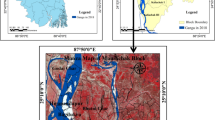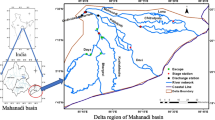Abstract
The Haihe River Basin is a semiarid water resources area of China. River ecosystem was degraded for high population density and intensive water resources development activities. To assist in the improvement of the ecological integrity of this river ecosystem, an environmental flow assessment model was developed that consider both spatial structure and dominant eco-function parameters. River ecosystem was divided into three sub-ecosystems which including river reach, wetland and estuary based on the spatial structure of river ecosystem. River reach was divided into three types which including habitat restoration type (HR), water quality restoration type (WQR) and vegetation restoration substitute water quantity restoration type (VRSWQR) according to their dominant eco-function. The spatio-temporal distribution of environmental flow (EF) for the river ecosystem in the Haihe River Basin was assessed based on the model. The results indicate that the EF for the river reach, wetland, and estuary are 2.267, 1.532, and 0.972 billion m3, respectively. The EF for HR type of river reach, the WQR type of river reach and VRSWQR type of river reach are 1.140, 1.138, and 0.154 billion m3, which are equal to 4.320, 4.312, and 0.584 % of the average annual flow of 26.39 billion m3, respectively. EF for river ecosystem in wet period (June–September), normal period (October–January) and dry period (February–May) are 2.999, 0.951, and 0.821 billion m3, respectively. Annual EF for river ecosystem of the Basin are 4.771 billion m3, which accounts for 18 % of the average annual flows of 26.39 billion m3.












Similar content being viewed by others
References
Acreman M, Dunbar MJ (2004) Defining environmental river flow requirements-a review. Hydrol Earth Syst Sc 5:861–876
Alcazάr J, Palau A (2010) Establishing environmental regimes in a Mediterranean watershed based on a regional classification. J Hydrol 388:41–51
Alcazάr J, Palau A, Vega-Garcìa C (2008) A neural net model for environmental flow estimation at the Ebro River Basin, Spain. J Hydrol 349:44–55
Arthington AH, Bunn SE, Poff NL, Naiman RJ (2006) The challenge of providing environmental flow rules to sustain river ecosystems. Ecol Appl 16:1311–1318
Bunn SE, Arthington AH (2002) Basic principles and ecological consequences of altered flow regimes for aquatic biodiversity. Environ Manage 30:492–507
Cao H, Hong Y, Li M, Gu JD (2012) Community shift of ammonia-oxidizing bacteria along an anthropogenic pollution gradient from the Pearl River Delta to the South China Sea. Appl Microbiol Biotech 94:247–259
Cui BS, Li X, Zhang KJ (2010) Classification of hydrological conditions to assess water allocation schemes for Lake Baiyangdian in North China. J Hydrol 385:247–256
Gleick PH (1998) Water in crisis: paths to sustainable water use. Ecol Appl 3:571–579
Gonzάlez A, Gortάzar J, Sanz B, Jalόn G (2008) Dam function rules based on brown trout flow requirements: design of environmental flow regimes in regulated streams. Hydrobiologia 609:253–262
Guo B, Wang LM (2011) Evolution of plain river ecosystem and the corresponding ecological restoration tactics of Haihe River Basin. Haihe Water Resour 6:10–15 (in Chinese)
Gupta AD (2008) Implication of environmental flow in river basin management. Phys Chem Earth 33:298–303
Haihe River Conservancy Commission of the Ministry of Water Resources, 2009.Water Resources Bulletin of Haihe River Basin (in Chinese)
Haihe River Conservancy Commission of the Ministry of Water Resources, 2010.Water Resources Bulletin of Haihe River Basin (in Chinese)
Hou P, Beeton RJS, Carter RW, Dong XG, Li X (2007) Response to environmental flows in the Lower Tarim River, Xinjiang, China: An ecological interpretation of water-table dynamics. J Environ Manage 83:383–391
Hughes DA, Hannart P (2003) A desktop model used to provide an initial estimate of the ecological instream flow requirements of rivers in South Africa. J Hydro 270:167–181
Jiang J, Yang ZF, Liu JL (2004) Study on ecological water requirement of stream-channel in the plain reach of Hai-River Basin. Geogr Geo-Inform Sci 5:81–83 (in Chinese)
Lin C, Lu ZL, Zhi DG, GuoY (2002) Study on eco-environmental restoration of Haihe River Basin. Water resources and Water Environment Carrying Capacity Symposium, Beijing. China Water Science Information Network (http://www.chinawater.net.cn/cwsnet/szycz/w020522-1.htm) (in Chinese)
Liu JL, Yang ZF, Xiao F, Sun T (2005) Conformity calculation models on river ecological basic flows. J Environ Sci 4:436–441 (in Chinese)
Liu JL, Yang ZF, Lin C, Wang Q (2006) Research on the rule of river basin eco-system demand. Chin Water Resour 13:18–21 (in Chinese)
Liu JL, Zeng WH, Zeng Y, Lin C, Yang ZF (2008) The optimal management of the urban river systems in the Haihe River Basin. Science Press, Beijing, China:3–20 (in Chinese)
Liu JL, Li YL, Zhang B, Cao JL, Cao ZG, Domagalski J (2009a) Ecological risk of heavy metals in sediments of the Luan River source water. Ecotoxicology 18:748–758
Liu JL, Ma MY, Zhang FL, Yang ZF, Domagalski J (2009b) The ecohealth assessment and ecological restoration division of urban water system in Beijing. Ecotoxicology 18:759–767
Liu JL, Chen QY, Li YL (2010) Ecological risk assessment of water environment for Luanhe River Basin based on relative risk model. Ecotoxicology 19:1400–1415
Liu JL, Chen QY, Li YL, Yang ZF (2011) Fuzzy synthetic model for risk assessment on Haihe River Basin. Ecotoxicology 20:1131–1140
Love F, Madamombe E, Marshall B, Kaseke E (2006) Preliminary estimate of environmental flow requirements of the Rusape River, Zimbabwe. Phys Chem Earth 31:864–869
Lu ZL, Zhang SH, Lin C, Liu DW (2010) Study on ecological protection and restoration mode of plain rivers in the Haihe River Basin. China Water Power Press:67–76 (in Chinese)
Ma MY, Liu JL, Wang XM (2011) Biofilms as potential indicators of macrophyte-dominated lake health. Ecotoxicology 20:982–992
Mazvimavi D, Madamombe E, Makurira H (2007) Assessment of environmental flow requirements for river basin planning in Zimbabwe. Phys Chem Earth 32:995–1006
Navratil O, Albert MB, Hérouin E, Gresillon JM (2006) Determinition of bankfull discharge magnitude and frequency: comparison of methods on 16-gravel bed river reaches. Earth Surf Process Landforms 31:1345–1363
Petts GE (2009) Instream flow science for sustainable river management. J Am Water Resour As 5:1071–1086
Poff NL, Zimmerman JKH (2010) Ecological responses to altered flows regimes: a literature review to inform the science and management of environmental flow. Freshw Biol 55:194–205
Poff NL, Allan JD, Bain MB, Karr JR, Prestegaard KL, Richter BD, Sparks RE, Stromberg JC (1997) The natural flow regime: a paradigm for river conservation and restoration. Biosci 47:769–784
Qin DY, Lu CY, Liu JH, Wang H, Zhang GH (2011) Study on dualistic water cycle mode and mechanisms of water resources evolvement of Haihe River Basin. Chin Sci Tech Achieve 23:37–40 (in Chinese)
Rapport DJ, Costanza R, McMichael AJ (1998) Assessing ecosystem health. Trends Ecol Evol 13:397–402
Renöfält BM, Jansson R, Nilsson C (2010) Effects of hydropower generation and opportunities for environmental flow management in Swedish riverine ecosystems. Freshwater Biol 55:49–67
Richter BD, Baumgartner JV, Powell J, Braun DP (1996) A method for assessing hydrological alteration within ecosystems. Conserv Biol 10:1163–1174
Richter BD, Warner AT, Meyer JL, Lutz K (2006) A collaborative and adaptive process for developing environmental flow recommendations. River Res Applic 22:297–318
Shen P, Zhou H, Gu JD (2010) Patterns of polychaete communities in relation to environmental perturbations in a subtropical wetland of Hong Kong. J Mar Biol Assoc UK 90:923–932
Shi W, Hou SY, Cui WY, Liu DW, Lin C (2010) Calculation of the ecological water demand of plain rivers in the Haihe River Basin based on river ecological types classification. J Agro-Environ Sci 10:1892–1899 (in Chinese)
Song GF, Shen B (2012) Research on river eco-environmental water requirements based on water function regionalization. J Xi’an Univ Tech 1:49–55 (in Chinese)
Sun T, Yang ZF (2005) Study on the approaches for quantifying the environmental flow in estuaries. J Environ Sci 5:573–579 (in Chinese)
Sun T, Yang ZF, Liu JL (2004) Study on the ecological water demands for typical estuaries in Haihe River Basin. Acta Ecol Sin 12:2707–2715 (in Chinese)
Tharme RE (2003) A global perspective on environmental flow assessment: emerging trends in the development and application of environmental flow methodologies for rivers. River Res Appl 19:397–441
Tharme RE, King JM (1998) Development of the building block methodology for instream flow assessments and supporting research on the effects of different magnitude flows on river ecosystems. Water Research Commission Report No 576/1/98, Pretoria, South Africa, pp.452
The Ministry of Water resourcess of the People’s Republic of China, 2002. Water Resourcess Regionalization Program of China (in Chinese)
The Ministry of Water resourcess of the People’s Republic of China, 2012. National Main River and Lake Water Functional Regionalization (in Chinese)
Xia J, Feng HL, Zhan CS, Niu CW (2006) Determination of a reasonable percentage for ecological water-use in the Haihe River Basin, China. Pedosphere 1:33–42
Xu JX (2004) A study of anthropogenic season rivers in China. Catena 55:17–32
Yang ZF, Liu JL, Xiao F, Jiang J, Lin C (2005) Conformity calculation of river ecological basic flows in the Haihe River Basin. J Environ Sci 4:442–448 (in Chinese)
Yang ZF, Sun T, Cui BS, Chen B, Chen GQ (2009) Environmental flow requirements for integrated water allocation in the Yellow River Basin, China. Commun Nonlinear Sci Numer Simul 14:2469–2481
Yang W, Yang ZF, Qin Y (2011) An optimization approach for sustainable release of e-flows for lake restoration and preservation: model development and a case study of Baiyangdian Lake. Chi Ecol Mode 222:2448–2455
Yang ZF, Cui BS, Sun T, Chen H, Yang W (2012) The theory, modelling, and allocation of wetland environmental flow. Science Press, Beijing (in Chinese)
Yang T, Liu JL, Chen QY, Zhang J, Yang Y (2013) Estimation of environmental flow requirements for the river ecosystem in the Haihe River Basin, China. Water Sci Technol 4:699–707
Yu YD, Yang ZY, Liu YP, Qin DY, Liu JH (2010) Review of study on precipitation evolution of Haihe River Basin under changing environment. J Chin Hydrol 4:32–35 (in Chinese)
Zhang Y, Zheng BH, Wang XQ, Hu C (2007) Study on ecological instream flow of the Hun River and Taizi River in Liao River Basin. J Environ Sci 6:937–943 (in Chinese)
Acknowledgments
The present study was supported by the National Natural Science Foundation of China (No. 41271496) and the National Water Pollution Control Major Project of China (No. 2012ZX07203-006).
Conflict of interest
The authors declare that they have no conflict of interest.
Author information
Authors and Affiliations
Corresponding author
Rights and permissions
About this article
Cite this article
Yang, T., Liu, J., Chen, Q. et al. Environmental flow assessment for improvement of ecological integrity in the Haihe River Basin, China. Ecotoxicology 23, 506–517 (2014). https://doi.org/10.1007/s10646-014-1219-5
Accepted:
Published:
Issue Date:
DOI: https://doi.org/10.1007/s10646-014-1219-5




